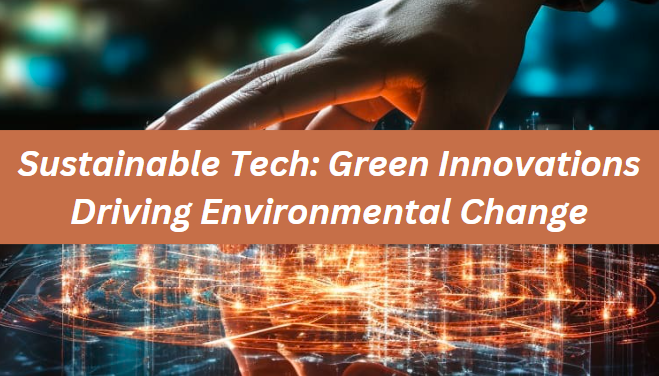As the world faces mounting environmental challenges, the role of sustainable technology has become increasingly crucial. Green innovations are not only helping to mitigate the effects of climate change but also fostering a more sustainable and resilient future. This guide explores the latest advancements in sustainable technology and how they are driving significant environmental change.
Contents
1. Introduction to Sustainable Technology
What is Sustainable Technology?
Sustainable technology refers to innovations that promote environmental sustainability by reducing carbon footprints, conserving resources, and minimizing waste. These technologies aim to meet present needs without compromising the ability of future generations to meet their own needs.
Importance of Sustainable Technology
- Climate Change Mitigation: Reduces greenhouse gas emissions and combats global warming.
- Resource Conservation: Efficient use of natural resources to prevent depletion.
- Economic Benefits: Promotes green jobs and sustainable economic growth.
- Health Improvements: Reduces pollution and enhances public health.
2. Renewable Energy Technologies
Solar Power
Solar power is one of the most prominent renewable energy sources. It converts sunlight into electricity using photovoltaic (PV) cells.
- Advancements:
- Perovskite Solar Cells: Offer higher efficiency and lower production costs.
- Bifacial Panels: Capture sunlight from both sides, increasing energy yield.
- Solar Roof Tiles: Integrate seamlessly with traditional roofing materials.
Wind Energy
Wind energy harnesses the power of wind to generate electricity using turbines.
- Advancements:
- Offshore Wind Farms: Utilize stronger and more consistent offshore winds.
- Vertical Axis Wind Turbines (VAWTs): Compact design suitable for urban areas.
- Smart Turbines: Use AI to optimize performance and reduce maintenance costs.
Hydropower
Hydropower generates electricity by harnessing the energy of flowing water.
- Advancements:
- Micro Hydropower Systems: Small-scale systems for rural and remote areas.
- Pumped Storage Hydropower: Stores energy by pumping water to higher elevations during low demand periods.
- Marine Energy: Utilizes tidal and wave energy for power generation.
3. Energy Storage Solutions
Battery Technologies
Advanced batteries are essential for storing renewable energy and ensuring a stable power supply.
- Advancements:
- Lithium-Ion Batteries: Improved energy density and longer lifespan.
- Solid-State Batteries: Increased safety and efficiency.
- Flow Batteries: Scalability and long-term storage capabilities.
Grid Energy Storage
Grid energy storage systems balance supply and demand, ensuring reliable electricity delivery.
- Advancements:
- Utility-Scale Batteries: Large-scale storage for grid stabilization.
- Hydrogen Storage: Converts excess electricity into hydrogen for later use.
- Compressed Air Energy Storage (CAES): Stores energy by compressing air and releasing it to generate power.
4. Sustainable Transportation
Electric Vehicles (EVs)
EVs reduce greenhouse gas emissions by using electricity instead of fossil fuels.
- Advancements:
- Battery Improvements: Extended range and faster charging times.
- Wireless Charging: Convenient and efficient charging solutions.
- Vehicle-to-Grid (V2G) Technology: Allows EVs to supply power back to the grid.
Public Transportation
Green innovations in public transportation reduce emissions and promote sustainable urban mobility.
- Advancements:
- Electric Buses: Zero-emission buses powered by electricity.
- Light Rail Systems: Energy-efficient urban transit solutions.
- Bicycle Sharing Programs: Eco-friendly transportation options in cities.
Sustainable Fuels
Alternative fuels reduce reliance on fossil fuels and lower emissions.
- Advancements:
- Biofuels: Derived from organic materials such as algae and agricultural waste.
- Hydrogen Fuel Cells: Produce electricity with water as the only byproduct.
- Synthetic Fuels: Manufactured from renewable resources and carbon capture.
5. Green Building Technologies
Energy-Efficient Buildings
Green buildings use less energy and resources while providing healthier living environments.
- Advancements:
- Passive House Design: Maximizes energy efficiency through insulation and airtight construction.
- Smart Building Systems: Uses IoT to optimize energy use and enhance comfort.
- Cool Roofs: Reflect sunlight to reduce cooling needs and urban heat islands.
Sustainable Materials
Eco-friendly building materials minimize environmental impact.
- Advancements:
- Recycled Materials: Use of recycled steel, glass, and plastics.
- Bamboo: Rapidly renewable and strong alternative to traditional timber.
- Green Concrete: Incorporates industrial byproducts and reduces CO2 emissions.
Water Conservation Technologies
Efficient water use and recycling are crucial for sustainable buildings.
- Advancements:
- Rainwater Harvesting Systems: Collect and reuse rainwater for irrigation and flushing.
- Greywater Recycling: Treats and reuses wastewater from sinks and showers.
- Smart Irrigation Systems: Use sensors and weather data to optimize water use.
6. Waste Management Innovations
Recycling Technologies
Advanced recycling processes improve the efficiency and effectiveness of waste management.
- Advancements:
- Robotic Sorting: AI-powered robots for precise material separation.
- Chemical Recycling: Breaks down plastics into their chemical components for reuse.
- Closed-Loop Recycling: Recycles materials back into the same products.
Waste-to-Energy
Converting waste into energy reduces landfill use and generates renewable power.
- Advancements:
- Anaerobic Digestion: Produces biogas from organic waste.
- Gasification: Converts waste into syngas for electricity generation.
- Plasma Arc Recycling: Uses high temperatures to convert waste into energy and reusable materials.
Circular Economy
A circular economy minimizes waste by designing products for longevity, reuse, and recycling.
- Principles:
- Design for Durability: Products built to last longer and be easily repairable.
- Product-as-a-Service: Shifts from ownership to access, promoting reuse and sharing.
- Resource Recovery: Maximizes the value of materials through continuous recycling.
7. Sustainable Agriculture
Precision Farming
Precision farming uses technology to optimize crop yields and resource use.
- Advancements:
- Drones: Monitor crop health and apply treatments precisely.
- IoT Sensors: Track soil moisture, temperature, and nutrient levels.
- Automated Machinery: Perform planting, harvesting, and maintenance with high efficiency.
Vertical Farming
Vertical farming grows crops in stacked layers, using less land and water.
- Advancements:
- Hydroponics: Grows plants in nutrient-rich water without soil.
- Aeroponics: Mists plant roots with nutrient solutions, enhancing growth rates.
- LED Lighting: Provides optimal light for plant growth with minimal energy use.
Sustainable Practices
Eco-friendly agricultural practices reduce environmental impact and improve soil health.
- Advancements:
- Regenerative Agriculture: Restores soil health through crop rotation, cover cropping, and reduced tillage.
- Organic Farming: Avoids synthetic pesticides and fertilizers.
- Agroforestry: Integrates trees and shrubs into farming systems for biodiversity and soil health.
8. Future Trends in Sustainable Technology
Artificial Intelligence and Machine Learning
AI and machine learning enhance the efficiency and effectiveness of sustainable technologies.
- Applications:
- Energy Management: Optimizes energy use in buildings and grids.
- Predictive Maintenance: Prevents equipment failures and extends lifespan.
- Environmental Monitoring: Tracks pollution levels and natural resource use.
Blockchain for Sustainability
Blockchain technology provides transparency and traceability in supply chains and resource management.
- Applications:
- Supply Chain Transparency: Ensures ethical sourcing and reduces fraud.
- Carbon Credits: Facilitates trading of carbon credits to incentivize emissions reductions.
- Decentralized Energy Grids: Enables peer-to-peer energy trading and local grid management.
Biotechnology
Biotechnology innovations promote sustainable agriculture, waste management, and energy production.
- Applications:
- Genetically Modified Organisms (GMOs): Enhance crop yields and resistance to pests.
- Biodegradable Plastics: Develop new materials that break down naturally.
- Bioenergy: Produce renewable energy from biological sources.
Conclusion
Sustainable technology is at the forefront of environmental change, driving innovations that address some of the world’s most pressing challenges. From renewable energy and energy storage to sustainable transportation and agriculture, these green technologies are paving the way for a more sustainable future. By embracing and investing in these innovations, we can create a healthier planet for future generations while also fostering economic growth and improving quality of life.




